#bedonkohe apache
Explore tagged Tumblr posts
Text

Geronimo and his warriors. One of the only known photos of Indian combatants still in the field who had not yet surrendered to the United States. C. S. Fly, March 1886. (source)
47 notes
·
View notes
Text

At his camp in the Sierra Madre at Canon de los Embudos, Mexico, March 25, 1886; shows Chuhuahua (prisoner of War), Calle, and Geronimo. - Fly - 1886
11 notes
·
View notes
Text
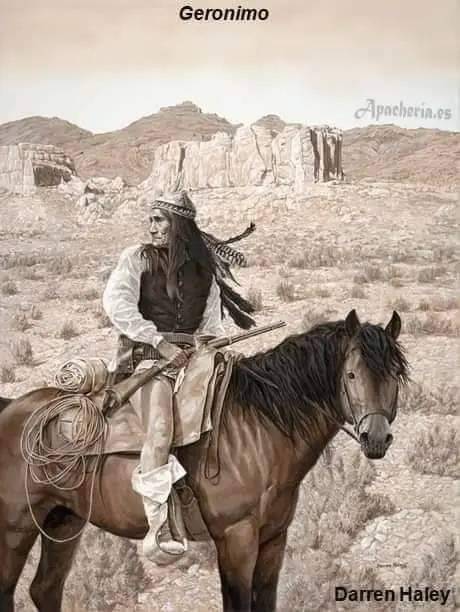
THE CHIRICAHUA APACHE NANTAN, GOYATLE (GERONIMO) IN WAR CAP :
Bedonkohe ...
Geronimo was born in what is today Arizona in the upper Gila River country on June 16, 1829. His birth name was Goyahkla, or "one who yawns." He was part of the Bedonkohe subsection of the Chiricahua tribe of Apaches, a small but mighty group of around 8,000 people ...
Apache nantans led from the front, so he might just be checking up on the column behind him. Many Apaches think he caused unnecessary decimation of the Chiricahua people; that he remained in the field too long, causing avoidable deaths. This nantan was blinded by revenge on the Mexicans. Full disclosure: he came home from what would pass for a shopping trip one day in 1851, and found his entire camp slaughtered by Mexican troops from Janos, Mexico. The dead included his mother Juana, wife Alope, and their three infant daughters. That Empire State Building sized horror, fell on one man all on the same day. So, you be the judge.
By 1884, he was in a bind. It became very difficult to recruit warriors from the reservations, as was the custom in earlier years. He even found himself competing with the US Cavalry for Apache men. The Army offered adult males jobs as scouts. Every scout was a warrior, but not every warrior became scouts. Those Army scouts were the albatross around his neck. They knew everything about him, the tribe and its refuges on both sides of the border. Every water hole, hiding place, arms cache, cave warehouses etc., were known to them. They would destroy winter stores piled up from summer operations in Mexico and Arizona/New Mexico. They essentially broke his back. By 1886, the pickings reached an all time low. He boiled down to 19 warriors; even resorted to child warriors. There were no bargaining chips left on the table from the 1884 talks. Geronimo was painted into a corner marked "unconditional surrender" ... When he finally handed over his rifle to General miles in September of 1886, there were only 38 people left in his band; half of them warriors. Deportation to Oklahoma, and what turned out to be a life sentence for him followed ...
The Chiricahuas served 27 years of incarceration 💔, before being released in 1913. It remains the longest confinement in US Military history ...
RIP Nantan Goyatle.
16 notes
·
View notes
Photo

Geronimo
Geronimo (Goyahkla, l. c. 1829-1909) was a medicine man and war chief of the Bedonkohe tribe of the Chiricahua Apache nation, best known for his resistance against the encroachment of Mexican and Euro-American settlers and armed forces into Apache territory and as one of the last Native American leaders to surrender to the United States government.
During the Apache Wars (1849-1886), he allied with other leaders such as Cochise (l. c. 1805-1874) and Victorio (l. c. 1825-1880) in attacks on US forces after Apache lands became part of US territories following the Mexican-American War (1846-1848). Between c. 1850 and 1886, Geronimo led raids against villages, outposts, and cattle trains in northern Mexico and southwest US territories, often striking with relatively small bands of warriors against superior numbers and slipping away into the mountains and then back to his homelands in the region of modern-day Arizona and New Mexico.
He surrendered to US authorities three times, but when the terms of his surrender were not honored, he escaped the reservation and returned to launching raids on settlements. He was finally talked into surrendering for good by First Lieutenant Charles B. Gatewood (l. 1853-1896), under the command of General Nelson A. Miles (l. 1839-1925), in 1886. None of the terms stipulated by Miles were honored, but by that time, Geronimo felt he was too old and too tired to continue running. Geronimo's surrender to Gatewood is told accurately, though with some poetic license, in the Hollywood movie Geronimo: An American Legend (1993).
Geronimo was imprisoned at Fort Pickens, Pensacola, Florida, before being moved to Fort Sill, Oklahoma. Toward the end of his life, he became a sensation at the St. Louis World's Fair (1904) and President Theodore Roosevelt's Inaugural Parade (1905) as well as other events. Although one of the stipulations of his surrender was his return to his homelands in Arizona, he was held as a prisoner elsewhere for 23 years before dying in 1909 of pneumonia at Fort Sill.
Name & Youth
His Apache name was Goyahkla ("One Who Yawns"), and, according to some scholars, he acquired the name Geronimo during his campaigns against Mexican troops, who would appeal to Saint Jerome (San Jeronimo in Spanish) for assistance. This was possibly Saint Jerome Emiliani (l. 1486-1537), patron of orphans and abandoned children, not the better-known Saint Jerome of Stridon (l. c. 342-420), translator of the Bible into the Vulgate and patron of translators, scholars, and librarians.
Geronimo was born near Turkey Creek near the Gila River in the region now known as Arizona and New Mexico c. 1825. He was the fourth of eight children and had three brothers and four sisters. In his autobiography, Geronimo: The True Story of America's Most Ferocious Warrior (1906), dictated to S. M. Barrett, Geronimo described his youth:
When a child, my mother taught me the legends of our people; taught me of the sun and sky, the moon and stars, the clouds, and storms. She also taught me to kneel and pray to Usen for strength, health, wisdom, and protection. We never prayed against any person, but if we had aught against any individual, we ourselves took vengeance. We were taught that Usen does not care for the petty quarrels of men. My father had often told me of the brave deeds of our warriors, of the pleasures of the chase, and the glories of the warpath. With my brothers and sisters, I played about my father's home. Sometimes we played at hide-and-seek among the rocks and pines; sometimes we loitered in the shade of the cottonwood trees…When we were old enough to be of real service, we went to the field with our parents; not to play, but to toil.
(12)
After his father died of illness, his mother did not remarry, and Geronimo took her under his care. In 1846, when he was around 17 years old, he was admitted to the Council of Warriors, which meant he could now join in war parties and also marry. He married Alope of the Nedni-Chiricahua tribe, and they would later have three children. Geronimo set up a home for his family near his mother's teepee, and as he says, "we followed the traditions of our fathers and were happy. Three children came to us – children that played, loitered, and worked as I had done" (Barrett, 25). This happy time in Geronimo's life would not last long, however.
Continue reading...
158 notes
·
View notes
Text

Geronimo of the Bedonkohe band of the Apache driving a motor car, 1905
Beside him is Edward Le Clair Sr., a Ponca Indian. Geronimo liked his vest, and it was gifted to him later that day. Geronimo was buried in that vest.
#reddit#historyporn#sealbhach#geronimo#car#1905#american indian#apache#edward le clair sr#ponca#indigenous#native american#vest#indigenous people#native people#native american heritage month
90 notes
·
View notes
Text
The Apache are a group of culturally related Native American tribes in the Southwestern United States, which include the Chiricahua, Jicarilla, Lipan, Mescalero, Mimbreño, Ndendahe (Bedonkohe or Mogollon and Nednhi or Carrizaleño and Janero), Salinero, Plains (Kataka or Semat or "Kiowa-Apache") and Western Apache (Aravaipa, Pinaleño, Coyotero, Tonto). Distant cousins of the Apache are the Navajo, with whom they share the Southern Athabaskan languages. There are Apache communities in Oklahoma and Texas, and reservations in Arizona and New Mexico. Apache people have moved throughout the United States and elsewhere, including urban centers. The Apache Nations are politically autonomous, speak several different languages, and have distinct cultures. Historically, the Apache homelands have consisted of high mountains, sheltered and watered valleys, deep canyons, deserts, and the southern Great Plains, including areas in what is now Eastern Arizona, Northern Mexico (Sonora and Chihuahua) and New Mexico, West Texas, and Southern Colorado. These areas are collectively known as Apacheria. The Apache tribes fought the invading Spanish and Mexican peoples for centuries. The first Apache raids on Sonora appear to have taken place during the late 17th century. In 19th-century confrontations during the American-Indian wars, the U.S. Army found the Apache to be fierce warriors and skillful strategists.

92 notes
·
View notes
Text

Geronimo, leader of the Bedonkohe Apache, taking a drive in a Locomobile Model C, 1905.
12 notes
·
View notes
Photo
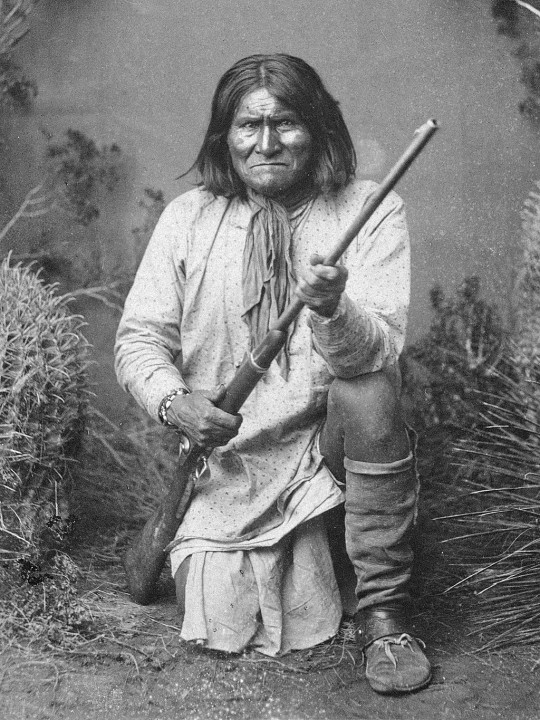
Geronimo
Geronimo (Goyahkla, c. 1829-1909) était un homme-médecine et un chef de guerre de la tribu Bedonkohe de la nation apache Chiricahua, surtout connu pour sa résistance contre l'empiètement des colons et des forces armées mexicains et euro-américains sur le territoire apache et pour avoir été l'un des derniers chefs autochtones à se rendre au gouvernement des États-Unis.
Lire la suite...
1 note
·
View note
Text
Ultimate Playlist: Men’s Names, G
Gandhi II by “Weird Al” Yankovic In the movie UHF, Al parodies commercials, TV shows, and film. This is a movie trailer that reimagines Gandhi as Rambo, putting the smack-down on bad guys and wooing the women.
George Of The Jungle by “Weird Al” Yankovic The theme to the 1967 animated TV series was written by Stan Worth and Sheldon Allman. Al covered it on his 1985 album “Dare to be Stupid,” and The Presidents of the United States recorded a version for the 1997 film.
The Killing Of Georgie (Parts 1 & 2) by Rod Stewart Stewart took some poetic license in the telling of this true story about a gay friend who was cast out by his parents, moved to New York, became very popular, but was inadvertently killed by a gang of thieves one night while walking home.
Georgy Porgy by Toto Playing off the nursery rhyme, the song suggests that the protagonist has chased away the girl he loves by being possessive of her.
Toss a Coin to Your Witcher by Sonya Belousova, Giona Ostinelli, & Joey Batey In world, this song is written by Jaskier, a bard, who is telling the story of how Geralt of Rivia fought a sylvan (half-man, half-goat), hoping to win over the common folk that don’t think highly of witchers.
Geronimo by Sheppard The song is using the custom of yelling “Geronimo” before doing a courageous act, like jumping out of an airplane. Gerónimo was a military leader and medicine man from the Bedonkohe band of the Ndendahe Apache people who led breakouts from the reservations in the late 1800’s. U.S. Army paratroopers started the tradition of shouting his name inspired by the 1939 film of the same name. Of course, this was an english pronunciation of his actual name: Goyaałé, which means “the one who yawns.”
A Boat Like Gideon Brown by Great Big Sea Gideon’s boat is big and strong, but the singer’s father’s boat was second hand. His father always swore that one day they would save enough to get a boat like Gideon’s.
Goldfinger by Shirley Bassey Written by John Barry, Leslie Bricusse, and Anthony Newley, it’s the title song from the 1964 James Bond film of the same name. The lyrics, comparing the villain to King Midas, were inspired by a scene in the film in which the character Jill Masterson is murdered by “skin suffocation” (not actually a thing) after being painted gold.
Heir Gordon by Bruce Hornsby I couldn’t find an explanation for this song. The title seems to parody Air Jordan, and the lyrics seem like they are mocking a specific person, but if so, Hornsby is keeping that to himself.
Gulliver/It’s Hay Chewed/Reprise by Elton John Gulliver is gone, but his memory remains in this final track from Elton’s first album.
0 notes
Text
On this day in history, Geronimo, Chiricahua Apache leader, and medicine man, died of pneumonia. February 17, 1909. Image: Geronimo (Goyaalé), a Bedonkohe Apache, kneeling with a rifle, 1887. (Public Domain) On this day in history, February 17, 1909, Geronimo, Chiricahua Apache leader and medicine man, died of pneumonia; while riding home on his horse, he was thrown off. He survived the night…
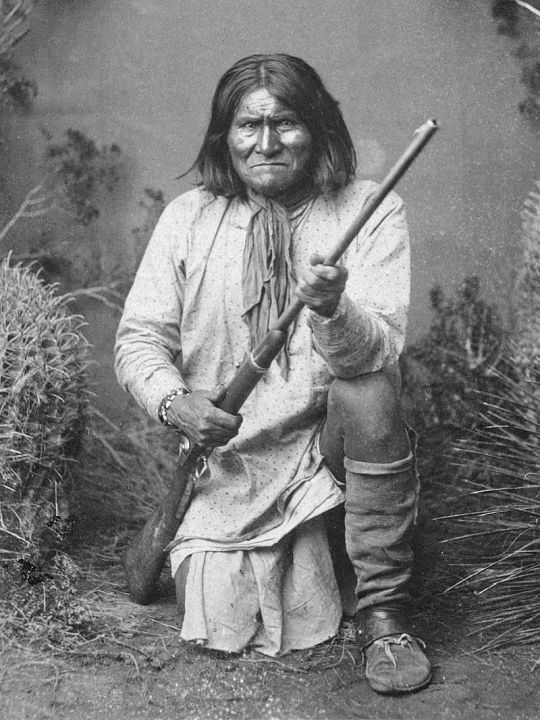
View On WordPress
1 note
·
View note
Text
Apache

@powwownative The Apache are a group of culturally related Native American tribes in the Southwestern United States, which include the Chiricahua, Jicarilla, Lipan, Mescalero, Mimbreño, Ndendahe (Bedonkohe or Mogollon and Nednhi or Carrizaleño and Janero), Salinero, Plains (Kataka or .....
1 note
·
View note
Photo

Geronimo at Fort Sill / J. E. Irwin - 1903
280 notes
·
View notes
Text
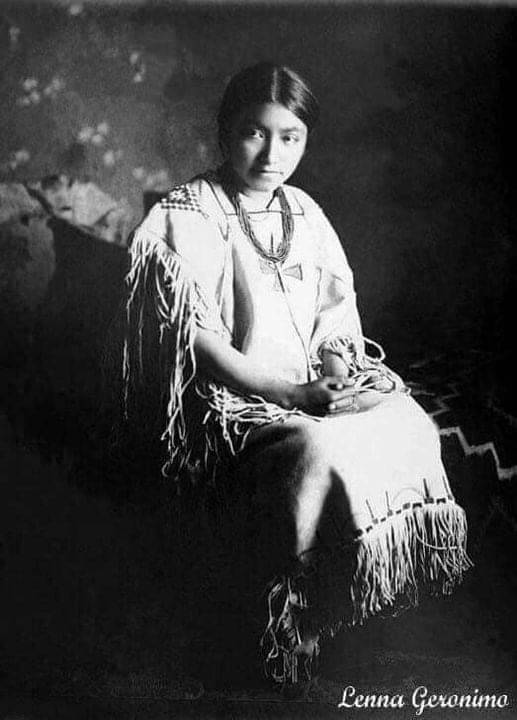
Geronimos daughter Lenna, photo ca. 1900. Lenna was born in 1886 in Fort Marion, St.Augustine, Fl, while her father was prisoner there. The Medical staff gave her the name Marion, after the fort, but she took back the name Lenna when returning to the South-West. Lenna Geronimo, the daughter of Geronimo and Ih-tedda, a Mescalero Apache, was the full sister of Robert Geronimo, Geronimos only living son.
Lenna was Bedonkohe-Mescalero Apache
57 notes
·
View notes
Quote
Geronimo's Song The song that I will sing is an old song, so old that no one knows who made it. It has been handed down through generations and was taught to me when I was but a little lad. It is now my own song. It belongs to me. This is a holy song (medicine-song), and great is its power. The song tells how, as I sing, I go through the air to a holy place where Yusun (The Supreme Being) will give me power to do wonderful things. I am surrounded by little clouds, and as I go through the air I change, becoming spirit only.
by Geronimo (Goyathlay)
#song#Apache#spirit#medicine#religion and spirituality#quote#sing#creator#supreme being#Native American#Bedonkohe band#medicine man#Arizona#Geronimo
3 notes
·
View notes
Text
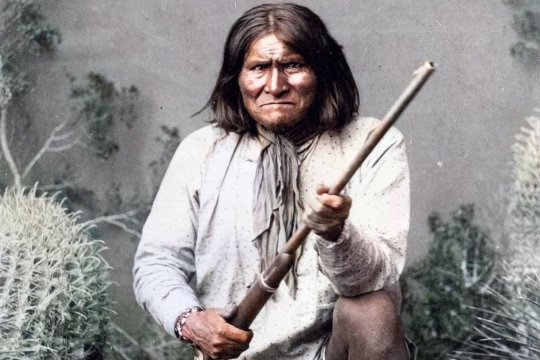
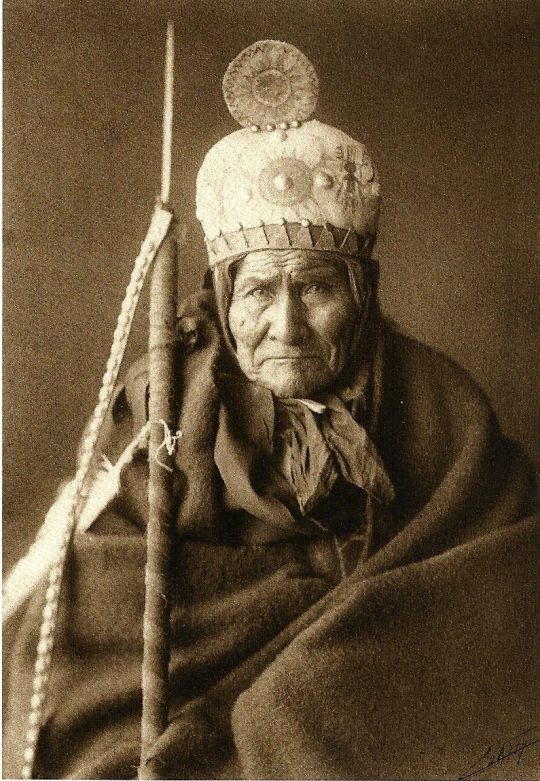
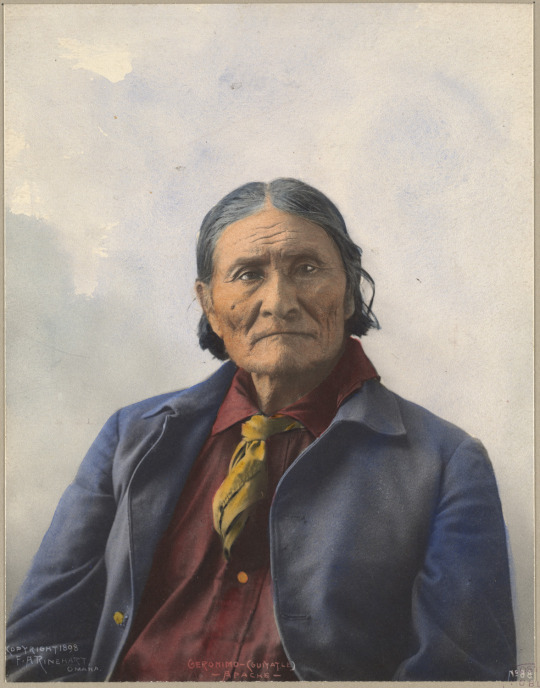
Geronimo 1829-1909
Geronimo (1829-1909) was an Apache leader and medicine man best known for his fearlessness in resisting anyone–Mexican or American—who attempted to remove his people from their tribal lands.
#geronimo#apache#native#native american#medicine man#chiricahua#bedonkohe#arizona#new mexico#mexico#indian
79 notes
·
View notes